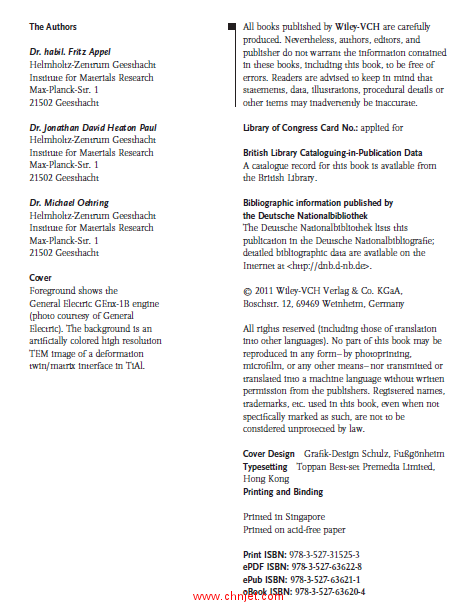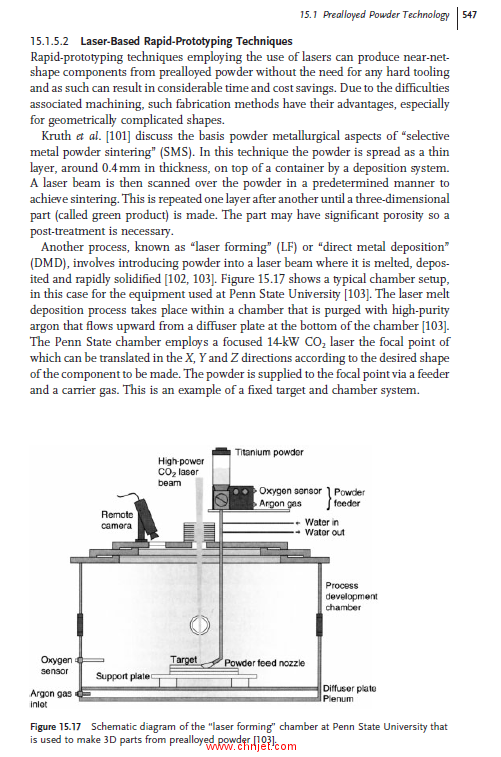马上注册,结交更多好友,享用更多功能,让你轻松玩转社区。
您需要 登录 才可以下载或查看,没有账号?立即注册

×
《Gamma Titanium Aluminide Alloys:Science and Technology》
伽玛钛铝合金:科学技术
作者:Fritz Appel, Jonathan David Heaton Paul,and Michael Oehring
出版社:Wiley
出版时间:2011年
《Gamma Titanium Aluminide Alloys:Science and Technology》

《Gamma Titanium Aluminide Alloys:Science and Technology》

《Gamma Titanium Aluminide Alloys:Science and Technology》

《Gamma Titanium Aluminide Alloys:Science and Technology》

目录
Preface XIII
Figures – Tables Acknowledgement List XV
1 Introduction 1
References 3
2 Constitution 5
2.1 The Binary Ti–Al Phase Diagram 5
2.2 Ternary and Multicomponent Alloy Systems 11
References 20
3 Thermophysical Constants 25
3.1 Elastic and Thermal Properties 25
3.2 Point Defects 27
3.3 Diffusion 29
References 30
4 Phase Transformations and Microstructures 33
4.1 Microstructure Formation on Solidifi cation 33
4.2 Solid-State Transformations 49
4.2.1 β → α Transformation 50
4.2.2 Formation of (α2 + γ) Lamellae Colonies 52
4.2.3 Feathery Structures and Widmannstätten Colonies 60
4.2.4 Massive Transformation 63
References 64
5 Deformation Behavior of Single-Phase Alloys 71
5.1 Single-Phase γ(TiAl) Alloys 71
5.1.1 Slip Systems and Deformation Kinematics 71
5.1.2 Planar Faults 75
5.1.3 Planar Dislocation Dissociations in γ(TiAl) 81
5.1.4 Nonplanar Dissociations and Dislocation Locking 85
VI Contents
5.1.5 Mechanical Twinning in γ(TiAl) 89
5.1.6 Effects of Orientation and Temperature on Deformation of
γ Phase 95
5.2 Deformation Behavior of Single-Phase α2(Ti3Al) Alloys 106
5.2.1 Slip Systems and Deformation Kinematics 106
5.2.2 Effects of Orientation and Temperature on Deformation of α2
Phase 112
5.3 β/B2 Phase Alloys 114
References 118
6 Deformation Behavior of Two-Phase α2(Ti3Al) + γ(TiAl) Alloys 125
6.1 Lamellar Microstructures 125
6.1.1 Interface Structures in Lamellar TiAl Alloys 125
6.1.2 Energetic Aspects of Lamellar Interfaces 136
6.1.3 Coherent and Semicoherent Interfaces 139
6.1.4 Coherency Stresses 149
6.1.5 Plastic Anisotropy 156
6.1.6 Micromechanical Modeling 161
6.2 Deformation Mechanisms, Contrasting Single-Phase and
Two-Phase Alloys 164
6.2.1 Methodical Aspects of TEM Characterization 164
6.2.2 Deformation of (α2 + γ) Alloys at Room Temperature 165
6.2.3 Independent Slip Systems 169
6.2.4 High-Temperature Deformation of (α2 + γ) Alloys 171
6.2.5 Slip Transfer through Lamellae 173
6.3 Generation of Dislocations and Mechanical Twins 178
6.3.1 Dislocation Source Operation in γ(TiAl) 178
6.3.2 Interface-Related Dislocation Generation 184
6.3.3 Twin Nucleation and Growth 186
6.3.4 Twin Intersections 197
6.3.5 Acoustic Emissions 204
6.3.6 Thermal Stability of Twin Structures 206
6.4 Glide Resistance and Dislocation Mobility 207
6.4.1 Thermally Activated Deformation 207
6.4.2 Glide Resistance at the Beginning of Deformation 217
6.4.3 Static and Dynamic Strain Aging of TiAl Alloys 222
6.4.4 Diffusion-Assisted Dislocation Climb, Recovery, and
Recrystallization 232
6.5 Thermal and Athermal Stresses 234
References 240
7 Strengthening Mechanisms 249
7.1 Grain Refi nement 249
7.2 Work Hardening 254
7.2.1 Work-Hardening Phenomena 255
Contents VII
7.2.2 Athermal Contributions to Work Hardening 257
7.2.3 Jog Dragging and Debris Hardening 259
7.2.4 Thermal Stability of Deformation Structures 262
7.2.5 High-Temperature Flow Behavior 268
7.2.6 High Strain-Rate Deformation 272
7.3 Solution Hardening 273
7.3.1 Elemental Size Misfi t of Solute Atoms with the TiAl Matrix 273
7.3.2 Survey of Observations 276
7.3.3 Effect of Solute Niobium 277
7.4 Precipitation Hardening 282
7.4.1 Carbide Precipitation in TiAl Alloys 282
7.4.2 Hardening by Carbides 284
7.4.3 Hardening by Borides, Nitrides, Oxides, and Silicides 289
7.5 Optimized Nb-Bearing Alloys 292
References 295
8 Deformation Behavior of Alloys with a Modulated Microstructure 301
8.1 Modulated Microstructures 301
8.2 Misfi tting Interfaces 306
8.3 Mechanical Properties 310
References 311
9 Creep 313
9.1 Design Margins and Failure Mechanisms 313
9.2 General Creep Behavior 314
9.3 The Steady-State or Minimum Creep Rate 316
9.3.1 Single-Phase γ(TiAl) Alloys 317
9.3.2 Two-Phase α2(Ti3Al) + γ(TiAl) Alloys 319
9.3.3 Experimental Observation of Creep Structures 320
9.4 Effect of Microstructure 322
9.5 Primary Creep 325
9.6 Creep-Induced Degradation of Lamellar Structures 329
9.7 Precipitation Effects Associated with the α2→γ Phase
Transformation 339
9.8 Tertiary Creep 340
9.9 Optimized Alloys, Effect of Alloy Composition and
Processing 341
9.10 Creep Properties of Alloys with a Modulated Microstructure 346
9.10.1 Effect of Stress and Temperature 346
9.10.2 Damage Mechanisms 347
References 352
10 Fracture Behavior 357
10.1 Length Scales in the Fracture of TiAl Alloys 357
10.2 Cleavage Fracture 360
VIII Contents
10.3 Crack-Tip Plasticity 362
10.3.1 Plastic Zone 362
10.3.2 Interaction of Cracks with Interfaces 365
10.3.3 Crack–Dislocation Interactions 367
10.3.4 Role of Twinning 369
10.4 Fracture Toughness, Strength, and Ductility 373
10.4.1 Methodical Aspects 373
10.4.2 Effects of Microstructure and Texture 376
10.4.3 Effect of Temperature and Loading Rate 383
10.4.4 Effect of Predeformation 387
10.5 Fracture Behavior of Modulated Alloys 388
10.6 Requirements for Ductility and Toughness 391
10.7 Assessment of Property Variability 393
10.7.1 Statistical Assessment 393
10.7.2 Variability in Strength and Ductility of TiAl 394
10.7.3 Fracture Toughness Variability of TiAl 396
References 398
11 Fatigue 403
11.1 Defi nitions 403
11.2 The Stress–Life (S–N) Behavior 405
11.3 HCF 407
11.3.1 Fatigue Crack Growth 407
11.3.2 Crack-Closure Effects 409
11.3.3 Fatigue at the Threshold Stress Intensity 411
11.4 Effects of Temperature and Environment on the Cyclic
Crack-Growth Resistance 413
11.5 LCF 418
11.5.1 General Considerations 418
11.5.2 Cyclic-Stress Response 419
11.5.3 Cyclic Plasticity 422
11.5.4 Stress-Induced Phase Transformation and Dynamic
Recrystallization 426
11.6 Thermomechanical Fatigue and Creep Relaxation 428
References 429
12 Oxidation Behavior and Related Issues 433
12.1 Kinetics and Thermodynamics 433
12.2 General Aspects Concerning Oxidation 437
12.2.1 Effect of Composition 437
12.2.2 Mechanical Aspects of Oxide Growth 439
12.2.3 Effect of Oxygen and Nitrogen 441
12.2.4 Effect of Other Environmental Factors 443
12.2.5 Subsurface Zone, the Z-Phase, and Silver Additions 446
12.2.6 Effect of Surface Finish 447
Contents IX
12.2.7 Ion Implantation 448
12.2.8 Infl uence of Halogens on Oxidation 450
12.2.9 Embrittlement after High-Temperature Exposure 450
12.2.10 Coatings/Oxidation-Resistant Alloys 456
12.3 Summary 458
References 459
13 Alloy Design 465
13.1 Effect of Aluminum Content 465
13.2 Important Alloying Elements – General Remarks 467
13.2.1 Cr, Mn, and V 468
13.2.2 Nb, W, Mo, and Ta 469
13.2.3 B, C, and Si 469
13.3 Specifi c Alloy Systems 471
13.3.1 Conventional Alloys 472
13.3.2 High Niobium-Containing Alloys 472
13.3.3 β-Solidifying Alloys 473
13.3.4 Massively Transformed Alloys 474
13.4 Summary 476
References 477
14 Ingot Production and Component Casting 479
14.1 Ingot Production 479
14.1.1 Vacuum Arc Melting (VAR) 480
14.1.2 Plasma-Arc Melting (PAM) 483
14.1.3 Induction Skull Melting (ISM) 489
14.1.4 General Comments 492
14.2 Casting 495
14.2.1 Investment Casting 497
14.2.2 Gravity Metal Mold Casting (GMM) 503
14.2.3 Centrifugal Casting 506
14.2.4 Countergravity Low-Pressure Casting 513
14.2.5 Directional Casting 514
14.3 Summary 515
References 515
15 Powder Metallurgy 521
15.1 Prealloyed Powder Technology 522
15.1.1 Gas Atomization 522
15.1.1.1 Plasma Inert-Gas Atomization (PIGA) at GKSS 524
15.1.1.2 Titanium Gas-Atomizer Process (TGA) 526
15.1.1.3 Electrode Induction Melting Gas Atomization (EIGA) 527
15.1.2 Rotating-Electrode Processes 529
15.1.3 Rotating-Disc Atomization 531
15.1.4 General Aspects of Atomization 532
X Contents
15.1.5 Postatomization Processing 542
15.1.5.1 Hot Isostatic Pressing (HIPing), Hot Working, and
Properties 543
15.1.5.2 Laser-Based Rapid-Prototyping Techniques 547
15.1.5.3 Metal Injection Molding (MIM) 549
15.1.5.4 Spray Forming 551
15.1.5.5 Sheet/Foil Production through (i) HIP of Cast Tapes and
(ii) Liquid-Phase Sintering 556
15.1.5.6 Spark Sintering 557
15.1.6 Summary 558
15.2 Elemental-Powder Technology 559
15.2.1 Reactive Sintering 559
15.2.1.1 Mechanical Properties of Reactive Sintered Material 563
15.2.1.2 Manufacture of Reactively Sintered Components/Parts 564
15.2.2 Summary 564
15.3 Mechanical Alloying 565
References 566
16 Wrought Processing 573
16.1 Flow Behavior under Hot-Working Conditions 574
16.1.1 Flow Curves 574
16.1.2 Constitutive Analysis of the Flow Behavior 578
16.2 Conversion of Microstructure 585
16.2.1 Recrystallization of Single-Phase Alloys 585
16.2.2 Multiphase Alloys and Alloying Effects 587
16.2.3 Infl uence of Lamellar Interfaces 595
16.2.4 Microstructural Evolution during Hot Working above the Eutectoid
Temperature 603
16.2.5 Technological Aspects 605
16.3 Workability and Primary Processing 607
16.3.1 Workability 607
16.3.2 Ingot Breakdown 617
16.4 Texture Evolution 642
16.5 Secondary Processing 658
16.5.1 Component Manufacture through Wrought Processing 658
16.5.2 Rolling – Sheet Production and Selected Mechanical Properties 662
16.5.2.1 Pack Rolling 663
16.5.2.2 Rolling Defects 666
16.5.2.3 Industrial Production of Sheet 667
16.5.2.4 Mechanical Properties of Sheet 668
16.5.2.5 Superplastic Behavior 669
16.5.3 Novel Techniques 671
16.5.3.1 Manufacture of Large “Defect-Free” Components 671
References 673
Contents XI
17 Joining 683
17.1 Diffusion Bonding 683
17.1.1 Alloy Compositions and Microstructures 684
17.1.2 Microasperity Deformation 685
17.1.3 Diffusion Bonding; Experimental Setup 687
17.1.4 Metallographic Characterization of the Bonding Zone 687
17.1.5 Effect of Alloy Composition 696
17.1.6 Infl uence of Bonding Time and Stress 698
17.1.7 Mechanical Characterization of the Bonds 700
17.2 Brazing and Other Joining Technologies 702
17.2.1 Brazing and Transient Liquid-Phase Joining 702
17.2.2 Other Techniques 704
References 704
18 Surface Hardening 707
18.1 Shot Peening and Roller Burnishing 707
18.2 Residual Stresses, Microhardness, and Surface Roughness 708
18.3 Surface Deformation Due to Shot Peening 712
18.4 Phase Transformation, Recrystallization, and Amorphization 716
18.5 Effect of Shot Peening on Fatigue Strength 721
18.6 Thermal Stability of the Surface Hardening 724
References 726
19 Applications, Component Assessment, and Outlook 729
19.1 Aerospace 729
19.1.1 Aircraft-Engine Applications 729
19.1.2 Exotic Aerospace Applications 731
19.2 Automotive 732
19.3 Outlook 736
References 737
Subject Index 739
专业书籍
下载地址:(回复后可见)
| ![]()